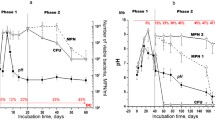Abstract
A potential method for the destruction of dormant Mycobacteriumsmegmatis (Msm) mycobacteria via photodynamic inactivation (PDI) using their ability to store endogenous porphyrins during the transition to a dormant state was studied. The dormant Msm cells were obtained under gradual acidification of the growth medium in the stationary phase for 14 days at different concentrations of ferric ions and the presence of 5-aminolevulinic acid in the growth medium. Cells were exposed to light at a wavelength of 532 nm emitted by an LLD10 laser for 5–60 min. It was shown that an increase in the coproporphyrin concentration in M. smegmatis after 6 days of growth correlated with the onset of a decrease in metabolic activity in cells and the formation of ovoid dormant forms. The dormant bacteria were sensitive to PDI and were destroyed after 15–30 min of illumination, in contrast to active cells. In the presence of 5-aminolevulinic acid and an optimal concentration of ferric ions (0.5 mg/L), there was an increase in the production of uroporphyrin in both active and dormant mycobacteria, which was accompanied by an increase in sensitivity to the action of PDI. The results demonstrate the promise of PDI for the destruction of dormant mycobacteria and the fight against latent tuberculosis.




Similar content being viewed by others
REFERENCES
Trutko, S.M., Shcherbakova, V.A., Ivanova, I.V., Lysanskaya, V.Ya., Arkhipova, O.V., Chuvil’skaya, N.A., Baskunov, B.P., Ostrovskii, D.N., and Akimenko, V.K., Microbiology (Moscow), 2008, vol. 77, no. 3, pp. 261–267.
Nikitushkin, V.D., Shleeva, M.O., Zinin, A.I., Trutneva, K.A., Ostrovsky, D.N., and Kaprelyants, A.S., FEMS Microbiol. Lett., 2016, vol. 363, no. 19, pp. 1–8.
Trutneva, K., Shleeva, M., Nikitushkin, V., Demina, G., and Kaprelyants, A., Front. Microbiol., 2018, vol. 9, p. 2083.
Kudykina, Yu.K., Shleeva, M.O., Artsatbanov, V.Yu., Suzina, N.E., and Kaprel’yants, A.S., Microbiology (Moscow), 2011, vol. 80, no. 5, pp. 625–636.
Bligh, E. and Dyer, W.J., Can. J. Phys., 1959, vol. 37, no. 8, pp. 911–917.
Kaprelyants, A., Salina, E., and Makarov, V., Int. J. Mycobacteriol., 2018, vol. 7, pp. 399–400.
Salina, E.G., Huszár, S., Zemanová, J., Keruchenko, J., Riabova, O., Kazakova, E., Grigorov, A., Azhikina, T., Kaprelyants, A., Mikušová, K., and Makarov, V., Metallomics, 2018, vol. 10, no. 7, pp. 992–1002.
Timofeeva, L.M., Kleshcheva, N.A., Shleeva, M.O., Filatova, M.P., Simonova, Y.A., Ermakov, Y.A., and Kaprelyants, A.S., Appl. Microbiol. Biotechnol., 2015, vol. 99, no. 6, pp. 2557–2571.
Bruce-Micah, R., Huttenberger, D., Freitag, L., Cullum, J., and Foth, H.J., J. Photochem. Photobiol., 2009, vol. 97, no. 1, pp. 1–7.
Sung, N., Back, S., Jung, J., Kim, K.H., Kim, J.K., Lee, J.H., Ra, Y., Yang, H.C., Lim, C., Cho, S., Kim, K., and Jheon, S., Photodiagn. Photodyn. Ther., 2013, vol. 10, no. 4, pp. 694–702.
O'Riordan, K., Sharlin, D.S., Gross, J., Chang, S., Errabelli, D., Akilov, O.E., Kosaka, S., Nau, G.J., and Hasan, T., Antimicrob. Agents Chemother., 2006, vol. 50, no. 5, pp. 1828–1834.
Wiegell, S.R., Kongshoj, B., and Wulf, H.C., Arch. Dermatol., 2006, vol. 142, no. 9, pp. 1241–1242.
Shih, M.H. and Huang, F.C., Invest. Ophthalmol. Vis. Sci., 2011, vol. 52, no. 1, pp. 223–229.
Feese, E. and Ghiladi, R.A., J. Antimicrob. Chemother., 2009, vol. 64, no. 4, pp. 782–785.
Hanakova, A., Bogdanova, K., Tomankova, K., Pizova, K., Malohlava, J., Binder, S., Bajgar, R., Langova, K., Kolar, M., Mosinger, J., and Kolarova, H., Microbiol. Res., 2014, vol. 169, nos. 2–3, pp. 163–170.
ACKNOWLEDGMENTS
During the research, the equipment of the Industrial Biotechnologies Center for Collective Use of the Federal State Institution, Fundamentals of Biotechnology Federal Research Center, Russian Academy of Sciences, was used.
Funding
Experiments on mycobacterial PDI were carried out with the support of the Russian Science Foundation, grant no. 19-15-00324. Dormant mycobacteria were characterized with the support of the grant of the Russian Science Foundation, no. 16-15-00245.
Author information
Authors and Affiliations
Corresponding author
Ethics declarations
The authors declare that they have no conflict of interest. This article does not contain any studies involving animals or human participants performed by any of the authors.
Rights and permissions
About this article
Cite this article
Shleeva, M.O., Savitsky, A.P., Nikitushkin, V.D. et al. Effect of Photodynamic Inactivation against Dormant Forms and Active Growing Cells of Mycobacterium smegmatis. Appl Biochem Microbiol 56, 285–291 (2020). https://doi.org/10.1134/S000368382003014X
Received:
Revised:
Accepted:
Published:
Issue Date:
DOI: https://doi.org/10.1134/S000368382003014X




